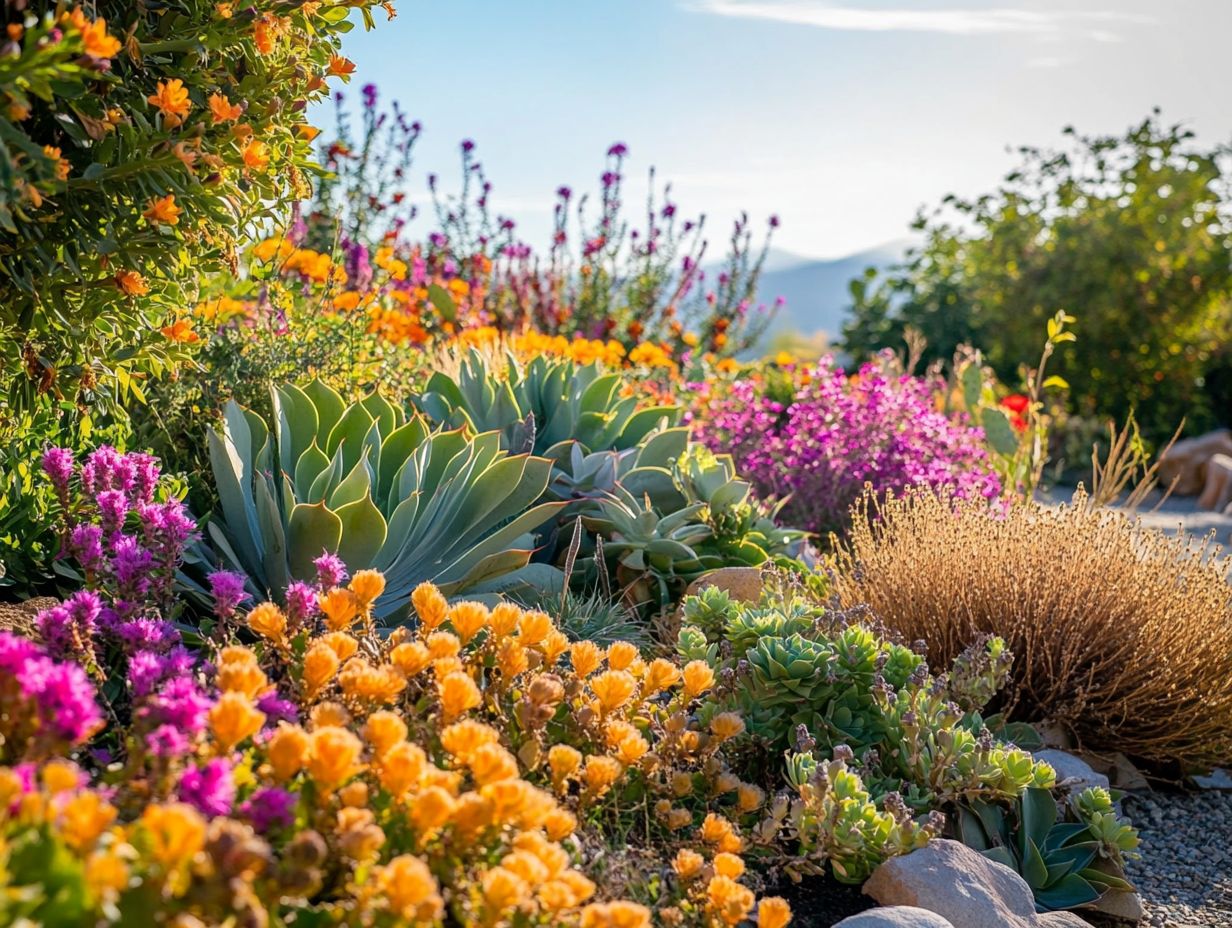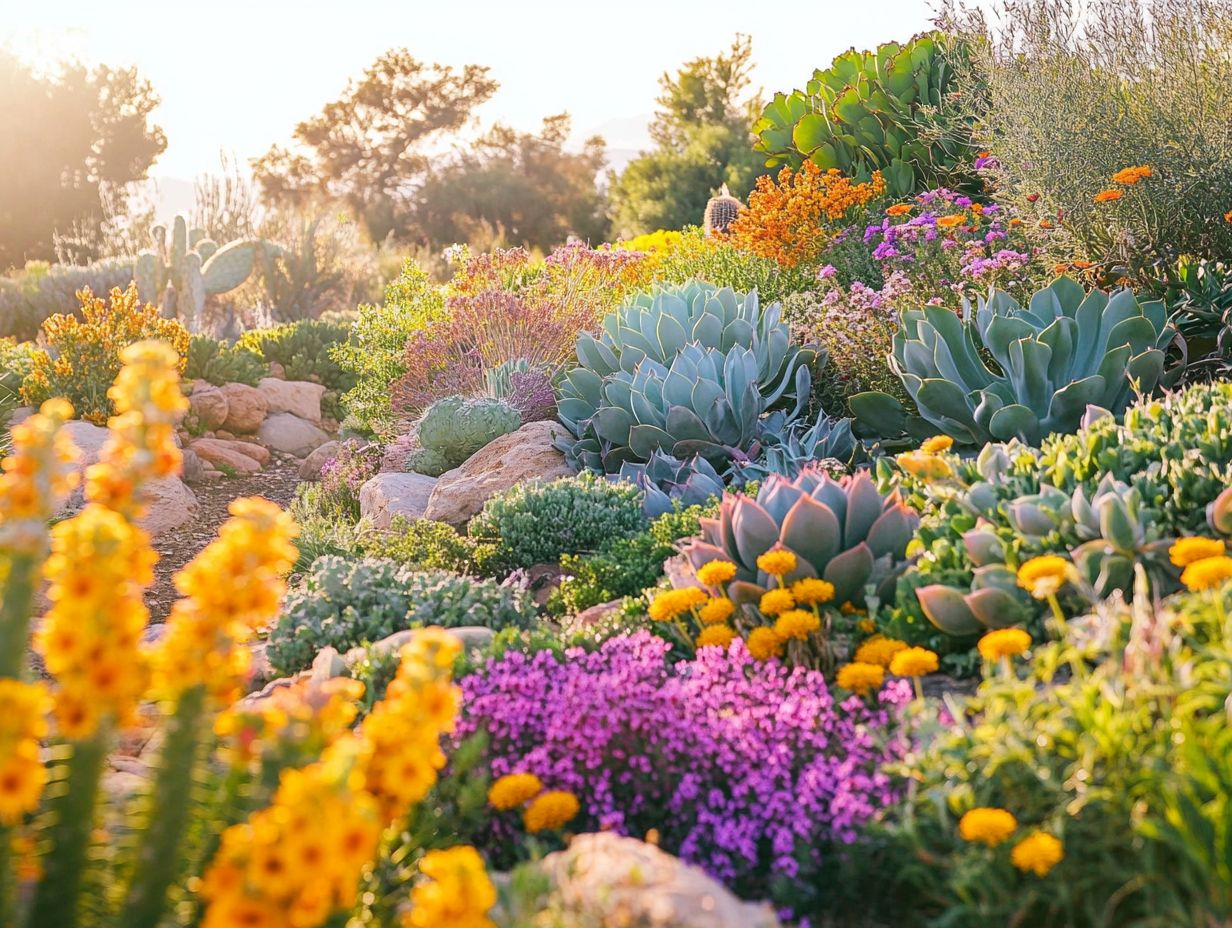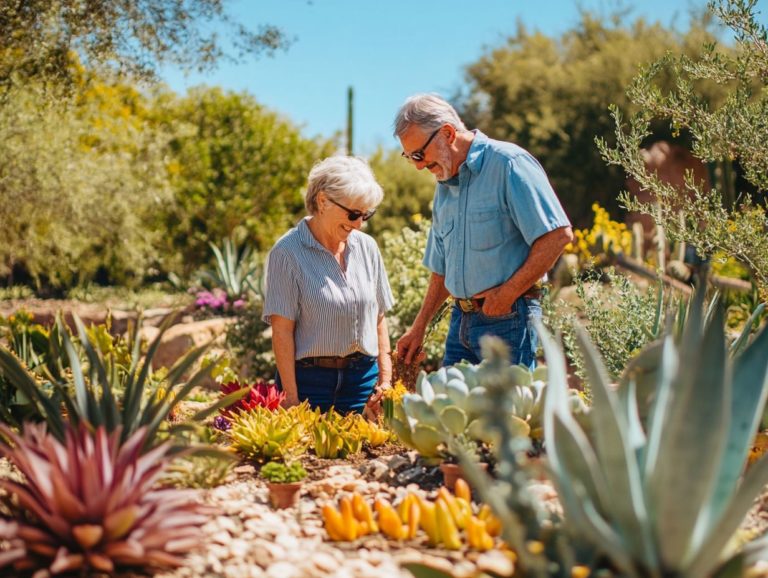Drought-Resistant Plants for a Colorful Garden
In a world increasingly challenged by climate change and water scarcity, transform your garden into a stunning oasis with drought-resistant plants that thrive on little water. Discover how these hardy beauties can change your gardening experience today!
Drought-resistant plants stand out as both a beautiful and practical solution for your gardening endeavors. These resilient plants not only conserve water but also introduce a vibrant palette of colors and textures that can elevate your landscape to new heights.
This article delves into the numerous benefits of incorporating drought-resistant plants into your garden, offers guidance on selecting the ideal species, and shares valuable insights on care and design to help you craft a stunning oasis of sustainability.
Contents
Key Takeaways:

- Drought-resistant plants save water and money while enhancing your garden’s beauty.
- When choosing drought-resistant plants, consider soil type, sun exposure, and water availability.
- Some top drought-resistant plants for a colorful garden include lavender, succulents, and coneflowers.
What are Drought-Resistant Plants?
Drought-resistant plants are your best allies for thriving in low-water conditions. They are perfect for gardens that face the relentless summer heat and drought.
These plants not only flourish in full sun and well-drained soil, but they also play a crucial role in sustainable landscaping by cutting down on water usage and maintenance needs in your outdoor gardening endeavors.
Gardening experts often recommend a curated selection of hardy varieties to ensure your garden bursts with vibrant colors and beautiful blooms, even in the most challenging climates.
Among these resilient options, perennial and native plants truly shine. They are well-suited to your local environment and enhance the variety of plants and animals around us.
Perennials, which live for more than two years, require minimal upkeep, while native species attract beneficial pollinators, contributing to a bustling ecosystem.
Choose heat-resistant varieties like agave or lavender to create an eye-catching, low-maintenance garden that flourishes in tough conditions. When you choose these drought-resistant flowers, you’re not just creating a beautiful landscape; you’re also making a sustainable choice that helps minimize your ecological footprint.
Benefits of Using Drought-Resistant Plants
Utilizing drought-resistant plants presents a wealth of advantages, such as conserving water, supporting pollinators, and elevating the beauty of your outdoor spaces.
These resilient plants are specifically designed to endure drought conditions, making them ideal for sustainable landscaping efforts and effective landscape management.
By incorporating these low-maintenance varieties into your gardening strategy, you can nurture a vibrant garden that flourishes, even under the summer sun.
Environmental and Cost Benefits
The environmental benefits of incorporating drought-tolerant plants into your garden go far beyond just visual appeal. These plants promote water conservation, reduce soil erosion, and enhance local biodiversity by utilizing native species.
By opting for low-water plants, you not only help the environment but also enjoy significant cost savings on irrigation and maintenance, making your garden a friend to both nature and your wallet.
These drought-resistant varieties are essential for ecological sustainability, as they help minimize the demand for precious water resources, particularly in areas prone to dryness.
Their ability to adapt to local climates fosters a strong ecosystem, preserving native species that support pollinators and other wildlife.
Choosing these plants also means reducing the need for synthetic fertilizers and pesticides, which lessens chemical runoff and encourages healthier soil.
By cutting back on irrigation, you contribute to sustainable landscaping practices, enhancing your garden while playing a vital role in conserving critical water supplies.
Ready to make a difference? Start planning your drought-resistant garden today!
Choosing the Right Drought-Resistant Plants

Selecting the perfect drought-resistant plants for your garden demands thoughtful consideration of several factors, such as local climate conditions, soil types, and the unique needs of your garden.
It s advisable to focus on hardy varieties that flourish in well-drained soil and full sun. This ensures a vibrant garden, even during the sweltering summer months. These plants are perfect for container planting.
Incorporating native plants enhances the ecological balance of your garden, creating a harmonious environment that benefits both you and the local ecosystem.
Factors to Consider
When selecting drought-resistant plants, consider various factors, including soil types, sunlight availability, and the specific needs of pollinators those insects that help plants reproduce, like bees and butterflies. Understanding whether your garden basks in full sun or enjoys partial shade can significantly impact flowering plants’ performance and overall growth.
In addition to sunlight, the composition of your soil is crucial in determining which plants will thrive. For example, sandy soils drain quickly and may require species that can handle dry conditions, while clay soils retain moisture but risk becoming waterlogged if not managed properly.
The presence of pollinators is vital for many flowering plants, influencing their ability to produce seeds and ensure continued growth. By observing these environmental factors, you can select species that not only flourish in your specific conditions but also positively contribute to local biodiversity and overall ecological health.
Top Drought-Resistant Plants for a Colorful Garden
Want a vibrant garden that thrives in any drought? Check out these top drought-resistant plants:
- Lavender
- Yarrow
- Blanket Flower
These stunning varieties not only showcase beautiful blooms but also attract pollinators, adding life to your garden while ensuring vibrant colors throughout the blooming seasons. They re ideal for sunny spots and can flourish across different blooming seasons, ensuring your garden remains a colorful spectacle throughout the year.
Examples and Characteristics
Consider incorporating some exceptional plant companions for drought-tolerant gardens into your garden, such as:
- Russian Sage
- Agastache
- Purple Coneflower
Each of these choices brings its own unique flair, featuring fragrant foliage and vivid colors that can elevate your outdoor space while supporting pollinator-friendly environments. These drought-tolerant gems flourish in full sun and well-drained soil, making them perfect for your gardening endeavors.
Take Russian Sage, for instance; it boasts silvery stems adorned with delicate lavender blooms, creating a soft, airy aesthetic that s ideal for cottage gardens. Then there’s Agastache, commonly known as hyssop, which surprises with its aromatic leaves and vibrant spikes of blue, orange, or pink flowers. It adds beauty and attracts pollinators like bees and butterflies, enhancing your garden’s liveliness.
And don t overlook the Purple Coneflower, which captures attention with its large, daisy-like purple petals and striking yellow centers. It serves as a captivating focal point in both formal and native plant landscapes. By selecting these plants, you’re not only conserving water but also enriching your garden s beauty and diversity.
Caring for Drought-Resistant Plants

Caring for drought-resistant plants is crucial for maintaining their health and beauty. By following maintenance tips and understanding their unique requirements like infrequent watering and ensuring they receive ample sunlight you can cultivate gardens that not only survive but flourish even in drought conditions.
Don t miss out on the chance to transform your garden today! Start your drought-resistant garden with these essential tips.
Tips for Maintenance and Growth
For thriving drought-resistant plants, tailor your maintenance strategies to their unique needs. Use techniques like drip irrigation and mulching to promote healthy growth while conserving water.
Drip irrigation delivers water directly to the roots, reducing waste. Regular soil testing helps identify nutrient needs, allowing for effective plant care without constant fertilization.
Choosing native plants that thrive in arid climates greatly reduces care requirements, leading to lower maintenance efforts and flourishing gardens. Adopting companion planting enhances biodiversity, allowing these resilient species to flourish even in demanding weather.
Designing a Drought-Resistant Garden
Designing a drought-resistant garden requires thoughtful planning centered on eco-friendly gardening methods and the careful selection of top drought-resistant plants for rock gardens that thrive in low-water conditions.
By incorporating a diverse array of drought-resistant plants, including native and low-maintenance varieties, you can learn how to design a drought-tolerant garden that flourishes in sunny areas and supports local biodiversity.
Incorporating Different Types of Plants
Incorporating a variety of plants, such as flowering groundcovers and hardy perennials, can elevate the visual appeal of your drought-resistant garden while nurturing a diverse ecosystem. For best results, choosing drought-resistant plants that are native to your region’s climate establishes a resilient garden capable of enduring drought conditions and attracting beneficial pollinators.
Choosing succulents like agave, which store water in their leaves, alongside ornamental grasses such as Blue Fescue, adds texture and movement while providing shelter for small wildlife. These plants promote soil health, prevent erosion, and enhance water retention, critical for sustaining biodiversity.
Including flowering species like lavender and yarrow attracts bees and butterflies, boosting pollination for your garden and surrounding flora. By integrating these diverse plant types, you cultivate not just an aesthetically pleasing space but also an ecosystem that thrives even in water scarcity.
Frequently Asked Questions

What are some drought-resistant plants that can add color to my garden?
Some great options for colorful drought-resistant plants include lavender, yarrow, rock rose, and blanket flower.
How can I ensure the survival of my drought-resistant plants in a colorful garden?
To ensure survival, choose native varieties, use mulch to retain moisture, and water deeply but infrequently.
Are there any flowering plants that are drought-resistant?
Yes, many flowering plants are drought-resistant, such as coneflowers, Black-eyed Susans, and salvia.
Can I create a colorful garden using only drought-resistant plants?
Absolutely! Many drought-resistant plants come in various colors, allowing you to create a beautiful garden while learning how to choose drought-resistant plants for your garden without sacrificing water conservation.
Do drought-resistant plants require a lot of maintenance?
No, most drought-resistant plants are low maintenance and require minimal watering and pruning, making them perfect for busy gardeners or those seeking a low-maintenance garden.
Are there any other benefits to using drought-resistant plants in my garden?
Besides conserving water, drought-resistant plants are often more pest and disease resistant, making them a great choice for a healthy and thriving garden.






